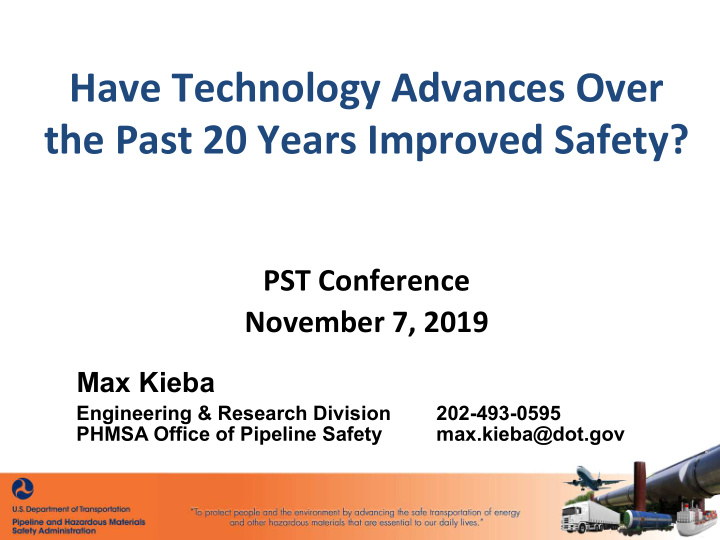



Have Technology Advances Over the Past 20 Years Improved Safety? PST Conference November 7, 2019 Max Kieba Engineering & Research Division 202-493-0595 PHMSA Office of Pipeline Safety max.kieba@dot.gov
A high level look at… • Improvements that have been made • Some gaps/areas for improvement • What can complicate advancement 2
Improvements we’ve seen or have influenced • In-line Inspection (ILI) sensor improvements and enhancements – better detection of dents, metal loss and cracks • Guided Wave – now in Part 192 via gas rule; there have been 50+ (probably 100+) PHMSA “no objections” for use on Gas and Hazardous Liquid systems – better understanding of how to use them as well as process improvements 3
R&D Performance History Since 2002 Technology Patent Patents Cost Applications Granted Tech-Transfer/ (U.S. + (U.S. + Commercialized Share Technology Technology PHMSA Projects Demonstrations Other) Other) Technologies ($M) ($M) Category Threat 23 11 3 3 5 $10.06M $11.50 Prevention M Leak Detection 15 9 2 0 6 $ 8.46M $ 6.03M Anomaly 42 27 22 7 14 $27.66M $31.21 Detection M Anomaly 9 3 0 0 1 $ 4.32M $ 2.80M Characterization Materials 7 2 2 2 1 $ 8.15M $ 7.98M Welding 7 5 0 0 2 $ 4.92M $ 6.12M Joining 3 2 1 0 0 $ 1.35M $ 1.36M Alternative Fuels 3 2 1 1 2 $ 1.09M $ 0.56M Totals: 109 61 31 13 31 $66M $68M
Examples of ILI related projects • Cathodic Protection Current Mapping In-Line Inspection Technology – commercially viable in-line inspection tool that measures current traveling in the pipe due to cathodic protection or stray current from sources other than the pipeline system's cathodic protection system – the data provides information used to diagnose problems with the cathodic protection system, coatings and others 5
Examples of ILI related projects • Completion of Development of Robotics Systems for Inspecting Unpiggable Transmission Pipelines – led to the commercial deployment of the first robotic inspection platform and integrated Magnetic Flux Leakage sensor capable of internal unpiggable gas pipeline inspection through many internal obstructions including plug valves. – device is an untethered, modular, remotely controllable, self-powered inspection robot for the visual and nondestructive inspection of 20" and 26" natural gas transmission and distribution system pipelines 6
Examples of ILI related projects • Improve and Develop ILI Tools to Locate, Size and Quantify Complex/Interacting Metal Loss Features – enabled a new Mechanical Damage Prioritization Process distinguishing dents with metal loss from dents with gouges – created a process by using multiple magnetic fields and field angles to distinguish a gouge from metal loss in a dent, as well as from a plain dent. • Search for other projects at: https://primis.phmsa.dot.gov/matrix/ 7
Research Technology Transfer Preventing Excavation Damage • GPS-based Excavation Encroachment Notification – UtilAlert by Hydromax https://www.hydromaxusa.com/ https://utilalert.com/ – Supports excavation only in marked areas – Minimizes damages and enhances public safety 20% 28% 3% 5% 3% 8% 25% 10% Pictures Courtesy of the Gas Technology Institute 8
Research Technology Transfer Methane Emissions Leak Detection • Natural Gas Pipeline Leak Rate Measurement System – Heath Consultants, Inc. https://heathus.com/ – Supports the MobileGuard™ gas leak-detection system – Improved methane/ethane analyzer – Two-dimensional gas leak rate imager—the first of its kind! Pictures Courtesy of Heath Consultants, Inc. 9
Research Technology Transfer Methane Emissions Leak Detection • Rapid Aerial Small Methane Leak Survey – Ball Aerospace and Technologies Corp. https://www.ball.com/aerospace – Fixed-wing differential absorption LiDAR (DIAL) technology – Plume imagery identifies methane/ethane and naturally-occurring sources (i.e, biogas) – A wider-swath sensor enables cost-effective area mapping Pictures Courtesy of Ball Aerospace and Technologies Corp. 10
Gaps/Areas of Continued Improvement • We don’t know what we don’t know – Don’t always get information about what the technology or process may have missed – Feedback loop from user to service provider • Leaks or ruptures where newer technology is being used 11
What’s not always working? • Sometimes not picking the right tool for the right defect, or miscall even if we think we have the right tool • Occasionally human errors in data interpretation, or some other breakdown in the system (people, process, procedures) • Not always integrating all the data available – ILI is still a snap shot in time; how are other leading/lagging indicators being considered? 12
What can complicate advancement? • Regulatory lag – Other technology notifications help, but previously limited to other technologies for integrity management assessments in HCAs (i.e. alternatives to ILI, pressure test, or direct assessment) – If special permit needed, takes additional time • Time to get comfortable with the technology 13
Improvements in other technology notification process • Gas Rule expedited time for notification (90 days vs. 180) and expanded scope of notifications to other aspects – Spike hydrostatic pressure test – Verification of pipeline material properties – Maximum Allowable operator pressure reconfirmation – Equivalent understanding of condition of the pipe for engineering critical assessments – Assessments outside of HCAs – Analysis of predicted failure pressure (material toughness for crack like defects) 14
What can we do? • More means to help prove a technology in realistic environment – What is proven in lab doesn’t always translate to field • Additional tracking of R&D funded tech transfer to determine extent of use 15
What can we do? • Further reduce miscalls in ILI tool interpretations and field verifications • Strengthen the feedback loop from user to service provider 16
What can we do? • Additional means to share data and lessons learned to wider group of stakeholders – Some is done in peer review groups, but little done publicly – Could Voluntary Information Sharing (VIS) help • Means to help integrate data into predictive modeling 17
Questions? Max Kieba 202-493-0595 max.kieba@dot.gov 18
Recommend
More recommend